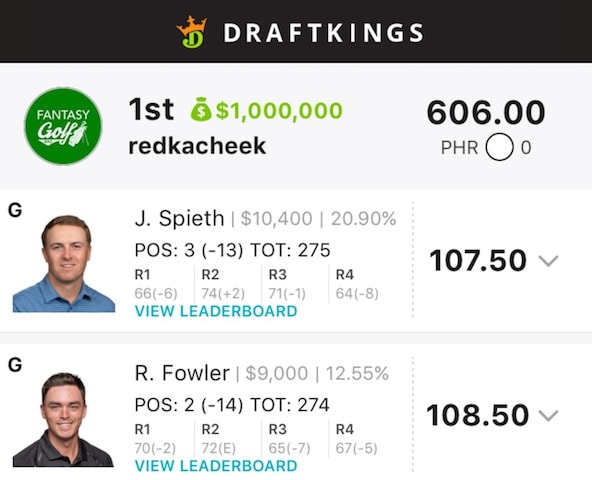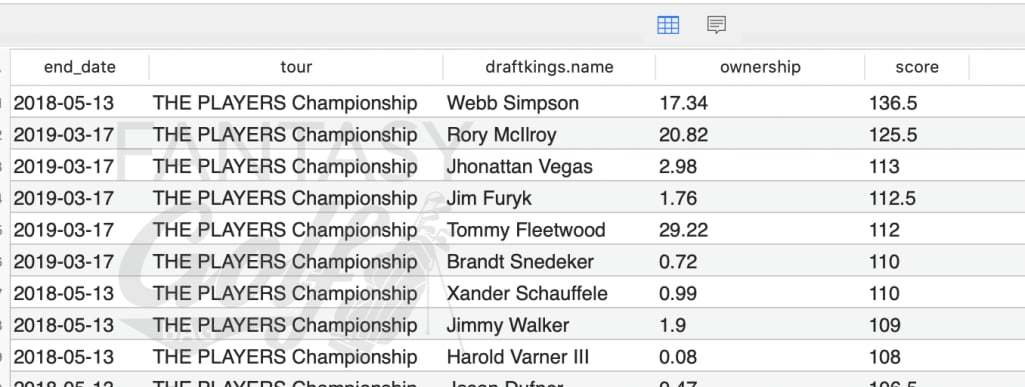
The DraftKings Millionaire Maker contest is one of, if not the most highly prized and sought-after contests to win in all of DFS golf. The thrill of throwing down $20 in the hopes of walking away with seven figures is a dream for everyone playing DFS. The odds are extremely stacked against you and the payout structure is so top-heavy that any mediocre or even above-average lineup will min-cash for 2x at best, and that is if you can beat 170,000 other participants. Luckily, our very own PGA analyst, Redkacheek, has won this enormous tournament and has some advice for those attempting to follow in his footsteps. As in all weeks, we will be covering the key players in our course preview and other weekly articles to provide you with the best information going into such a huge week, but this article is aimed toward helping you better strategize your Millionaire Maker lineups. As you read below, you will find several important concepts and strategies that you should be thinking about when preparing for the DraftKings Millionaire Maker tournament.
Play to win – The prize pool is ridiculously top heavy. To get the attention that DraftKings is aiming for, you need a huge first prize but with that, the rest of the prize pool is depleted.
Here is the prize breakdown:
|
1st |
$1,000,000.00 |
|
2nd |
$150,000.00 |
|
3rd |
$75,000.00 |
|
4th |
$50,000.00 |
|
5th |
$30,000.00 |
|
6th |
$20,000.00 |
|
7th – 8th |
$15,000.00 |
|
9th – 10th |
$7,000.00 |
|
11th – 15th |
$5,000.00 |
|
16th – 20th |
$3,500.00 |
|
21st – 25th |
$2,500.00 |
|
26th – 30th |
$1,500.00 |
|
31st – 40th |
$1,000.00 |
|
41st – 50th |
$700.00 |
|
51st – 75th |
$500.00 |
|
76th – 100th |
$350.00 |
|
101st – 150th |
$250.00 |
|
151st – 250th |
$200.00 |
|
251st – 500th |
$150.00 |
|
501st – 1000th |
$120.00 |
|
1001st – 2250th |
$100.00 |
|
2251st – 5000th |
$80.00 |
|
5001st – 11000th |
$60.00 |
|
11001st – 23000th |
$40.00 |
|
23001st – 46675th |
$30.00 |
With such a top-heavy prize pool, specifically first place, our ultimate goal is to win it, not just place well. Of course, it would be nice to win $150,000 but even to finish second in such a big tournament would take a phenomenal lineup and the mindset of finishing first would definitely help. These lineups should be quite different than your typical GPPs and certainly cash lineups. You need to have the mentality of picking a team to win it all rather than trying to get six guys through the cut in hopes that other people made mistakes.
The perfect lineup – In order to win the Millionaire Maker, you are going to need all six of your golfers in the top 10, including the winner. So, to do that we should avoid including any players we do not think could finish in the Top 10. Easy enough, although when your player pool gets too large you will be forced to use extremely cheap “value” plays to compensate for say … Rory McIlroy at $12.2k. This is not the correct strategy for the Milly Maker. Unlike most other events, making the cut and outperforming their price-tag are not factors in the Millionaire Maker. Unless you feel 100% confident the most expensive player is going to win and only win, then you would be wise to fade him in order to structure the rest of your team perfectly for your desired player pool.
In other words, your player pool should consist of players you can see winning or at least contending; making the cut simply isn’t good enough.

Pay attention to ownership – I’m sure you here about ownership leverage quite a lot, but in such a large-field GPP tournament, having some strong players under-owned will really go a long way. You do not need to be searching the bottom-of-the-barrel but definitely pay close attention to ownership and perhaps take a stand against extremely popular plays, whether due to price, recent form, statistics, etc. and avoid them altogether. That alone will give you a 70% edge if they happen to perform poorly. Ownership is key, but too many people will go looking for a 1% guy to pair with three of their 20% (or higher) players, when that “low-owned” player will be 1% for a reason: he is not a good play. So be careful with your ownership stands but definitely pay attention to your player pool and the potential ownership your players will carry. In general, 90% is a cap you should use when constructing your rosters.

Ignore value, play to win – Again, we are going to need six guys in the Top 10 and obviously you are going to need the Winner on your roster. With that said, is Justin Thomas a good value at $11,100? Probably not, even if he does win the tournament. The “value” is determined by final fantasy points to price, so of course there could be a $6k player who finished top 20 with a better “value” but having Dustin Johnson win will be a tremendous amount of raw fantasy points regardless of his value. Our advice is selecting players for your player pool that can win or finish Top 10, regardless of price.
Don’t go contrarian to be contrarian – This point goes in line similarly to the value plays, but too many times people try to get cute with their player pool or lineup construction and in all honesty, they have taken themselves out of the tournament before it even begins. There are many times when a contrarian play is “sneaky” yet most times they are contrarian because they are a bad play and nothing about them says they are going to play well. Contrarian plays should be attained by seeing a player at $9,300 being an obvious play (think Collin Morikawa) yet Xander Schauffele is at $9,400. All ownership will go to Morikawa, so pivoting to Schauffele would be a contrarian play. Don’t get cute, do your research and make good choices from the top range to the bottom.
Good chalk, bad chalk – As you probably know, chalk is simply a term for the most popular plays. There is both good chalk — those popular plays that are expected to play well for a plethora of reasons — and bad chalk, the popular players who are expected to do well for exogenous reasons. You should never shy away from good chalk; the best players are usually going to be most popular. But then identifying bad chalk can be difficult and takes extra work. Case in point: Do not just follow the herd and expect all popular plays to be good. Figure out the underlying factors for their perceived performance and make your own decisions.
Script it if you can – Most people do not have the luxury of entering multiple lineups into the Milly Maker, let alone maxing out 150 entries. If you only have one entry or two, you are best off to hand build those lineups to make your “optimal” lineup. For those that have the luxury of 10, 20, 50 or even 100 or 150 lineups, your best bet to have a nice blend of exposures is to use a script/optimizer. Luckily, FTN offers our projections with a native instance of SaberSim built right in that can build hundreds of lineups within seconds. SaberSim does much more than script lineups though, as it offers the ability to customize simulations based on the contests you are playing. The reason scripting is so powerful is that it allows you to create your own player pool and then the algorithm simply creates lineups with your designated exposures so that you have no bias to who you are picking in each lineup. Your “picking” was done when you narrowed down your player pool. SaberSim can do a ton of prework for you before you start building lineups, by utilizing the advanced settings. Both “ownership fade” and “smart diversity” are ways for you to avoid too chalky of lineups, and also offer real performance expectations to provide nice balanced exposure. Look out for more in-depth tutorials for SaberSim or take a look at Kyle Murray’s PGA video each week.
Best of luck in all of your contests. We hope to see another FTN member taking home a Milly Maker this year.


















































 New York Jets
New York Jets  New England Patriots
New England Patriots  Miami Dolphins
Miami Dolphins  Buffalo Bills
Buffalo Bills  Pittsburgh Steelers
Pittsburgh Steelers  Cleveland Browns
Cleveland Browns  Cincinnati Bengals
Cincinnati Bengals  Baltimore Ravens
Baltimore Ravens  Tennessee Titans
Tennessee Titans  Jacksonville Jaguars
Jacksonville Jaguars  Indianapolis Colts
Indianapolis Colts  Houston Texans
Houston Texans  Las Vegas Raiders
Las Vegas Raiders  Los Angeles Chargers
Los Angeles Chargers  Kansas City Chiefs
Kansas City Chiefs  Denver Broncos
Denver Broncos  Washington Commanders
Washington Commanders  Philadelphia Eagles
Philadelphia Eagles  New York Giants
New York Giants  Dallas Cowboys
Dallas Cowboys  Minnesota Vikings
Minnesota Vikings  Green Bay Packers
Green Bay Packers  Detroit Lions
Detroit Lions  Chicago Bears
Chicago Bears  Tampa Bay Buccaneers
Tampa Bay Buccaneers  New Orleans Saints
New Orleans Saints  Carolina Panthers
Carolina Panthers  Atlanta Falcons
Atlanta Falcons  San Francisco 49ers
San Francisco 49ers  Seattle Seahawks
Seattle Seahawks  Los Angeles Rams
Los Angeles Rams  Arizona Cardinals
Arizona Cardinals 




 Boston Celtics
Boston Celtics  Brooklyn Nets
Brooklyn Nets  Philadelphia 76ers
Philadelphia 76ers  New York Knicks
New York Knicks  Toronto Raptors
Toronto Raptors  Chicago Bulls
Chicago Bulls  Detroit Pistons
Detroit Pistons  Milwaukee Bucks
Milwaukee Bucks  Cleveland Cavaliers
Cleveland Cavaliers  Indiana Pacers
Indiana Pacers  Orlando Magic
Orlando Magic  Atlanta Hawks
Atlanta Hawks  Charlotte Hornets
Charlotte Hornets  Miami Heat
Miami Heat  Washington Wizards
Washington Wizards  Denver Nuggets
Denver Nuggets  Minnesota Timberwolves
Minnesota Timberwolves  Oklahoma City Thunder
Oklahoma City Thunder  Portland Trail Blazers
Portland Trail Blazers  Utah Jazz
Utah Jazz  LA Clippers
LA Clippers  Golden State Warriors
Golden State Warriors  Los Angeles Lakers
Los Angeles Lakers  Phoenix Suns
Phoenix Suns  Sacramento Kings
Sacramento Kings  Dallas Mavericks
Dallas Mavericks  Houston Rockets
Houston Rockets  Memphis Grizzlies
Memphis Grizzlies  New Orleans Pelicans
New Orleans Pelicans  San Antonio Spurs
San Antonio Spurs 









